| |
|
|
|
|
| |
An International Flashpoint |
|
|
|
| |
|
|
|
|
| |
Abuse of Aboriginal Title & Rights |
|
Wilderness: Awe vs Annihilation |
|
| |
Corrupt Politics: the Downward Spiral |
|
The Struggle of Environmentalism |
|
| |
Corporate Greed: Stump to Dump |
|
A Brave Stand: Betty! |
|
| |
|
|
|
|
| |
|
|
| |
|
|
|
|
| |
Abuse of Aboriginal Title & Rights
The rich biodiversity of the Northwest Coast is reflected in the many languages and cultures of the indigenous peoples which are among the most varied in the world. In the wake of the late 19th century colonization of British Columbia (BC), the Indians were displaced, their resources stolen and their Aboriginal Title and Rights ignored. Today vast corporate profits that do not benefit First Nations people continue to be made from unceded lands. Canada's refusal in 2007 to sign the UN Convention on Indigenous Rights exposes the influence of the international resource extraction industry in obstructing the legal and moral obligation of Canada to settle aboriginal land claims. Haida artist Michael Nicoll Yahgulanaas pictures the insatiable invader, the "Monster of Gluttony," gobbling up the forests of Haida Gwaii (right). |
|
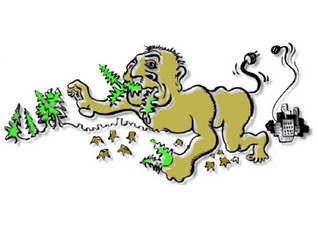
"Eating Haida Gwaii."
Michael Nicoll Yahgulanaas |
|
| |
|
|
|
|
| |
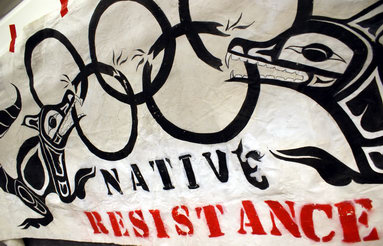
"Native Resistance" banner, 2008.
Photo: Native Youth Movement |
|
A banner by the Native Youth Movement raised at the "Why Resist 2010?" forum held in Vancouver in 2008 (left). The activists opposed the 2010 Winter Olympics because they were held on unceded indigenous land. They claim that BC has no legal right to exist, let alone expropriate land and govern over sovereign First Nations. The Native Youth Movement rejects BC's fraudulent treaty process, conducted while the government continues to sell, lease and develop disputed indigenous lands for the profit of speculators and resource extraction corporations. Meanwhile Indians suffer the highest rates of poverty, bad health and imprisonment in Canada. Protests are frequent among First Nations including the Haida, Tahltan, Kwakwakawk'a, Nuu chah nulth, Coast Salish, Secwepemc, St'at'imc and Nuxalk. |
|
| |
|
|
 |
|
| |
Canada is Janus faced in concealing its ruthless exploitation of the forests and its degrading of native culture and identity. Canadian prime ministers and other political officials may acknowledge the magnificence of the primaeval rainforest for nationalistic purposes but in reality their forest policies have always been supportive of the exploitative international forest industry. On the one hand Canada constructs its identity abroad by Northwest Coast art such as totem pole and mask carvings, and on the other it is wiping out the old growth cedar trees and forests essential for the perpetuity of the indigenous culture.
Typical is the cynical PR ploy by Canada to increase German tourism to its shores by marketing native culture and nature tourism, as in the case of a 2009 travelling exhibit of indigenous "treasures" from the collection of Canada's Museum of Civilization (right). One venue is the State Museum of Lower Saxony: Indianer Kanadas. The Haida mask used to promote the exhibit was "collected" in 1884 from Haida Gwaii, during the first large scale European plundering of indigenous Northwest Coast. Similar artifacts are on permanent exhibit in the Grand Hall of the Canadian Museum of Civilization. Also the museum mounts frequent exhibits such as the 2009 "Celebration of BC" which displays work by contemporary Northwest Coast carvers. Nowhere in these popular celebrations of indigenous culture is any connection made with or objection to the deforestation that is wiping out the totem trees and ancient groves in BC. |
|
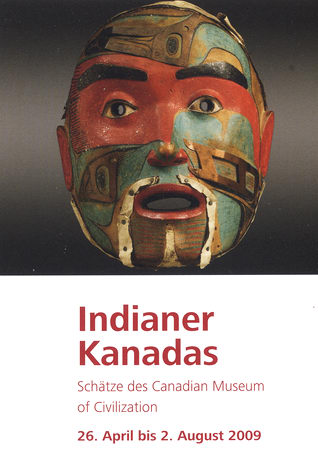
Indianer Kanadas, 2009.
State Museum of Lower Saxony |
|
| |
|
|
|
|
| |
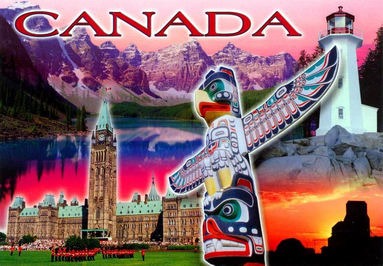
Indianer Kanadas, 2009.
State Museum of Lower Saxony
Traditional knowledge refers to the knowledge, innovations and practices of indigenous and local communities around the world. Developed from experience gained over the centuries and adapted to the local culture and environment, traditional knowledge is transmitted orally from generation to generation. It tends to be collectively owned and takes the form of stories, songs, folklore, proverbs, cultural values, beliefs, rituals, community laws, local language, and agricultural practices, including the development of plant species and animal breeds. Traditional knowledge is mainly of a practical nature, particularly in such fields as agriculture, fisheries, health, horticulture, and forestry.The Convention on Biological Diversity was inspired by the world community's growing commitment to sustainable development. It represents a dramatic step forward in the conservation of biological diversity, the sustainable use of its components, and the fair and equitable sharing of benefits arising from the use of genetic resources. |
|
As Indigenous Peoples, our fight is the same the world over. Indigenous Title and Rights are ignored, dismissed and violated. many countries adopted the UN Declaration but continue to deny the international legal reality of our Indigenous Title and Rights.
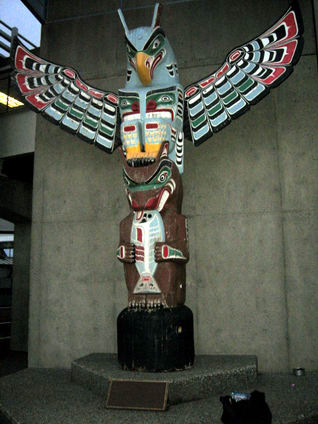
xxxxxx
xxxx
|
|
| |
|
|
|
|
| |
the peoples of the region
were savages; the landscape was a wilderness; Europeans would bring civilization
to Native peoples and tame wild nature. By the middle of the nineteenth
century, the peoples and landscapes of Vancouver Island and the
British Columbia mainland had been entered into imperial geographical
imaginations; for Europe they represented the other, but they were also capable,
to some degree, of becoming Europe.
Most of BC is designated as "Crown
Land," or so called "Public Land" to be held in
trust by the government. In fact, this land has never been given
up by the Indigenous Peoples and their Aboriginal Title and Rights
remains an unresolved legal issue. BC's economy has been built
on the forest industry and the BC government continues to back
the interests of transnational logging companies over and above
the land title and rights of First Nations and settler communities
that depend on longterm sustainable forestry.
Preservationists and First Nations can
both achieve their goals when the giant corporations' forest
tenures are rescinded. Recognizing aboriginal title creates as
much heated debate in B.C. as the preservation of more wilderness.
Why? Because both threaten the tenure of the multinational forest
companies. It is in interest of these companies to have forest
workers feel threatened by the claims of preservationists and
natives and to inflame irrational prejudices and fear while continuing
to reap the rich profits form liquidating the ancient forest.
There is plenty of forested land in B.C. to arrive at a just
settlement of aboriginal land claims (which we're legally and
morally obligated to do), create an adequate wilderness preservation
system and sustain a "working forest" that could supply many
more jobs than the woods do today. But it necessitates the redistribution
of land now licensed to the multinationals and the institutionalization
of a new set of forest practices. |
|
A Vancouver Island native group has won a ruling that will force the Canadian government to defend its domestic human rights record at an international tribunal later this year.The Inter-American Commission on Human Rights has approved the Hul'qumi'num Treaty Group's petition to hear the case against Canada. The native group contends that their human rights were violated by the privatization of their traditional territory – roughly 300,000 hectares of land on the east coast of Vancouver Island that was taken in the 1800s and converted to private property. The IACHR, an autonomous body of the Organization of American States, has found the B.C. treaty process has demonstrated it is not an effective mechanism to protect the alleged aboriginal victims' rights.Robert Morales, chief negotiator for the treaty group, is intent on using to the case to alter the future of treaty-making in B.C., where most of the land base – and future development – is still subject to aboriginal land claims. “Instead of land claims, I think we need to change the dialogue to human rights,” he said in an interview. Mr. Morales is well-positioned to change that dialogue. He's part of a working group of B.C. chiefs with the task of moving the moribund treaty process forward. The B.C. government has pushed for treaty settlements as a means to end the uncertainty that has hampered investment. Because unsettled land claims hang over most of the province, development such as mining is frequently held up in litigation. The treaty task force was set up last summer, after the failure of the provincial government's attempt to create a sweeping law to recognize aboriginal title. The ambitious Recognition and Reconciliation Act was abandoned in the face of criticism from both industry and native communities, and now native leaders are developing a strategy to move forward. The chiefs' task force is due to come back with a proposal in March, and the Hul'qumi'num's approach could provide the chiefs with a new road map, said Mr. Morales, who represents more than 6,000 aboriginal people on Vancouver Island and the Gulf Islands. “We need to find a way to have Canada and B.C. recognize the aboriginal treaty rights of first nations in B.C.,” he said. “Canadians pride themselves on their human rights record, but they don't associate the huge disparity between people living on reserves and people living off reserves as a question of human rights.” Although the province is pressing ahead with individual treaties, there is no broad agenda to settle the land question. George Abbott, B.C.'s aboriginal relations minister, said there is progress on the treaty front, noting there are several native bands that are expected to vote on proposed treaties this year. “I'm pretty optimistic we are going to make some progress in 2010 on aboriginal issues,” he said in an interview. But the province is focusing on deals with bands where there is an appetite for settlement. The Hul'qumi'num ancestral lands, which were converted to railway lands, are now privately owned by forest companies. That means B.C. and Canada won't even discuss most of the land the tribes' claim as their traditional territories because it is no longer Crown land. The Inter-American Commission on Human Rights found Canadian courts “do not seem to provide any reasonable expectations of success, because Canadian jurisprudence has not obligated the state to set boundaries, demarcate and record title deeds to lands of indigenous peoples.” Both Canada and the treaty group have been given several months to prepare for the hearing, which is expected to proceed in the fall. Chuck Strahl, federal Indian Affairs Minister, could not be reached for comment yesterday. It is rare for the international tribunal to take on a Canadian native rights issue. Mike Mitchell of the Akwesasne reserve near Cornwall, Ont., asked the commission to uphold native rights to transport cigarettes and alcohol across the border. The commission ruled against Mr. Mitchell. |
|
| |
|
|
|
|
|
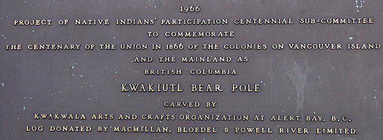
mmm
mmmm
Welcome to the Traditional Knowledge Information Portal, which has been developed by the Secretariat of the Convention on Biological Diversity in order to promote awareness and enhance access by indigenous and local communities and other interested parties to information on traditional knowledge, innovations and practices relevant for the conservation and sustainable use of biological diversity. It aims to provide useful and timely information especially as traditional knowledge in relation to the programme of work for Article 8(j) and Related Provisions. |
|
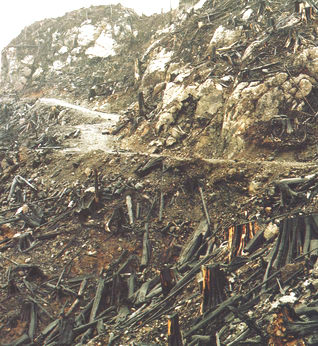
Indianer Kanadas, 2009.
State Museum of Lower Saxony |
|
| |
|
|
|
|
| |
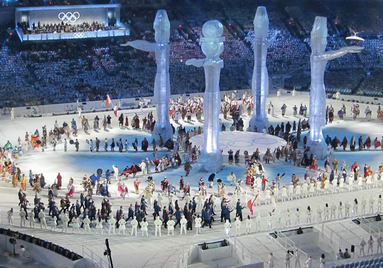
Opening Ceremony with traditional Welcome figures.
Winter Olympics, Vancouver, 2010 |
|
mm
mm
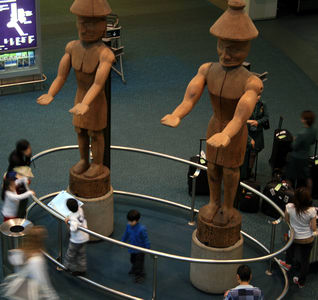
Welcome figures by Joe David.
Vancouver International Airport |
|
| |
|
|
|
|
| |
|
|
| |
|
|
|
|
| |
What Google Earth Tells Us About Deforestation
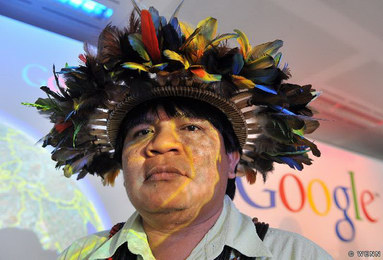 |
Left: Chief Almir Surui, head of the Surui Amazon tribe in Brazil, at a Google Earth Outreach event in 2008. One of the best ways to monitor the logging industry is through satellite technology. Corporate deforestation hides itself behind devious collaboration schemes and green rhetoric to deflect public attention from the senseless devastation revealed by Google Earth.
Google Earth Outreach has assisted the Brazilian tribe to protect their forest homeland from illegal mining and logging. Google space imagery, digital maps and 3D depictions of terrain show native villages, hunting grounds, sacred and cultural sites, as well as natural resources areas and their encroachment by industry. Similar technology can be used by First Nations to prove ancient occupation and land rights, but only as long as the contested land is not stripped of its ancient forests. |
|
Right: Google Earth Logging Flyover (click to enlarge)
Google Earth was also used to fight a proposed logging plan near Los Gatos in northern California. The plan by the San Jose Water Company was to log 1,000 acres in the Los Gatos Creek Watershed including the largest remaining stand of coastal redwood forest (Sequoia Sempervirens) in Santa Clara County.
The Los Gatos Creek Watershed provides drinking water to over 100,000 Silicon Valley residents. To protect it from corporate and environmental vandalism, residents founded "Neighbours Against Irresponsible Logging." The group remapped the corporate logging plan using Google Earth satellite imagery. |
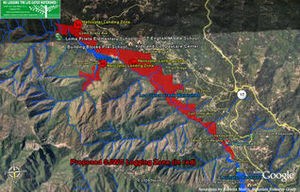 |
|
|
|
| |
|
|
|
|
| |
The Vanishing of Totem Trees The recognition and celebration of Northwest Coast culture must address the destruction of the ancient forests by the logging industry. Totem poles are indeed testaments to the durability and survival of the indigenous peoples, but they are also symbolic of the vanishing primaeval rainforest habitat on the Northwest Coast. A valuable new learning resource for the complex relationship between culture and nature that defines the art of totem poles is the website presented by the Bill Holm Center for the Study of Northwest Coast Art at the Burke Museum of Natural History and Culture, University of Washington, Seattle (right). The website project confirms the flourishing of this monumental art form: "poles are being raised up and down the Northwest Coast, and the villages are alive again with the sounds of ancestral songs and ceremonies"
The Enduring Powers of Totem Poles.
Kwakiutl Protest In 2005 the Kwakiutl First Nation was forced to demonstrate against the BC government's sleazy land transfers to Western Forest Products. Totem poles are cultural ambassadors all over the world today and the Thunderbird motif of the Kwakiutl (right) has become emblematic of indigenous culture. Yet the Kwakiutl People continue to have their Aboriginal Title and Rights abused. Totem poles cannot be proclaimed to represent indigenous cultural survival when such abuse remains endemic and when the ancient cedar trees and forests in which indigenous Northwest Coast culture is embedded continue to be obliterated by unscrupulous logging companies. |
|
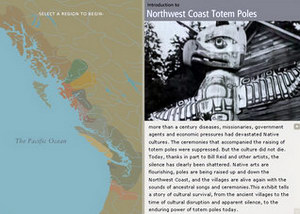
"The Enduring Power of Totem Poles" |
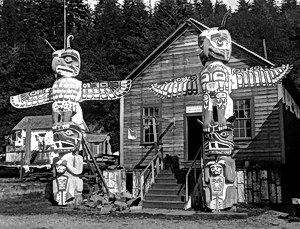 |
|
Kwakiutl Thunderbird Poles, c. 1910 |
|
|
| |
|
|
| |
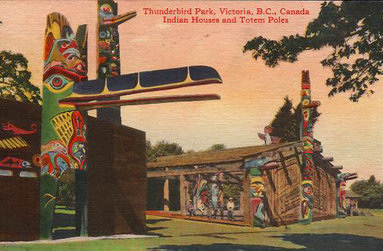
Nuxalk Raven Pole from Talyu (foreground).
Thunderbird Park, Victoria, BC
How Dare They Do This Unbelievably, in 2006 an ancient stand of Sitka spruce trees on Vancouver Island, not far from Cathedral Grove, was slaughtered. The brutal demise of this irreplaceable and priceless nature treasure known as the Pachena Grove is a shocking instance of the ruthlessness of the forest industry in Canada. Even the location of the Pachena Grove at the head of the internationally acclaimed West Coast Trail, next to one of Canada's most popular national parks, did not deter the logging companies from engineering a devious "co opting" strategy. Their despicable act of destroying Pachena Grove, an endangered and rare tract of old growth rainforest biodiversity, is not only an ecological crime, it is a tragic loss to Nuu chah nulth culture and Huu ay aht identity. Surprisingly, a documentary film about the 1,000 year old giant trees ("Mammutbaeume") shown in Germany on ARTE in 2009 makes no mention of the old growth deforestation that is ruining Nuu chah Nulth land, although an ad for the film shows some of the ugly clearcuts that deface Clayoquot Sound behind the Tlaoquiaht forest activist and totem pole carver Joe Martin (right). |
|
Land Infringement at Taleomey Narrows The world renown of the indigenous Bella Coola (Nuxalk) culture has not stopped the industrial resource exploiters. In 2009 one of the most productive sites of Northwest Coast culture, the ancient Nuxalk community at Talyu – most famous for its Raven house entry pole (left) – was invaded by heli loggers and their log dumps. Recognition is owed to the Nuxalk people, many of them Elders, who have courageously defended their land and waters against the relentless pillaging by extraction companies such as Interfor, operating with full government complicity.
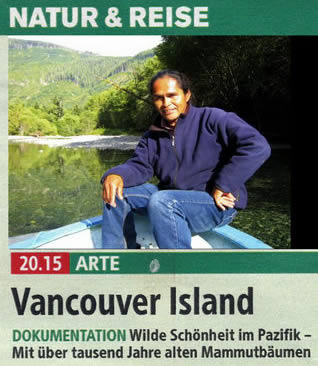
Vancouver Island documentary film.
Broadcast in Germany on ARTE, 2009 |
|
| |
|
|
 |
|
| |
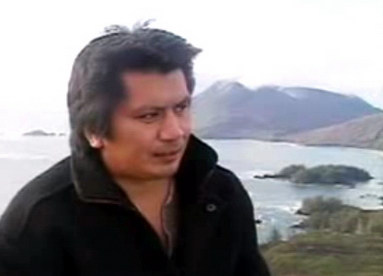
Screenshot of Quatsino Ralph Wallis.
"Severing the Web on Vancouver Island"
East Creek Massacre 2003 The assault, pillage and rape of Quatsino forest lands continues into the new millenium (right). BC's greedy forest industry has left First Nations a shameful legacy of poverty and stumps. Unless international condemnation results in a boycott of the commercial trade in red and yellow cedar trees, Northwest Coast art and culture will be severely diminished. Precious nature treasures such as the wild salmon and a myriad of other native species dependent on the ancient rainforest habitat are disappearing, as already evidenced in California, Oregon and Washington. |
|
Quatsino The Quatsino indigenous people have greatly suffered due to the loss of biodiversity along with the plundering of their culture. Magnificent Quatsino totem poles and carvings are on display at museums around the world, yet this has not stopped the logging industry from cutting the roots of this art form. In a video showing the shocking clearcut destruction of northern Vancouver Island in the 1990s, Quatsino Ralph Wallis (left) speaks of his sadness and despair over the industrial carnage of his homeland:
Severing the Web on Vancouver Island.
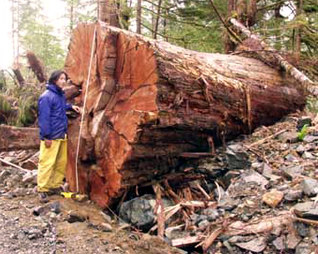
Ancient cedar, Quatsino land, 2003.
Photo: Wilderness Committee |
|
| |
|
|
 |
|
| |
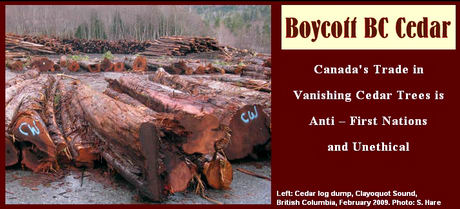
Above: Boycott BC Cedar Gallery (click to view)
Cedar and other old growth logs, Clayoquot Sound, 2009
Right: A Vanishing Heritage: The Loss of Ancient Red Cedar
from Canada's Rainforests (click for pdf) |
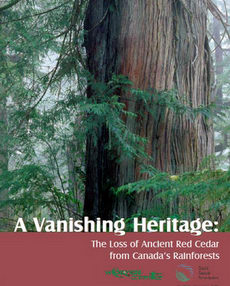 |
|
|
| |
|
|
|
|
| |

Indianer Kanadas, 2009.
State Museum of Lower Saxony |
|
There are two processes currently underway. One that is coming quickly to a decision point is what is known as the New Relationship. The purpose of the New Relationship is to recognize and accommodate and reconcile the aboriginal title and rights of the First Nations in B.C. Now, that process is going into its third year with very little significant progress. Meanwhile the large cedar logs needed for First Nations carving traditions are becoming scarce. Tla o qui aht First Nation artist Joe David carved the two welcome figures at the Vancouver Airport (right). Northwest Coast art will disappear if the industrial logging of old growth cedar is not stopped. |
|
| |
|
|
|
|
| |
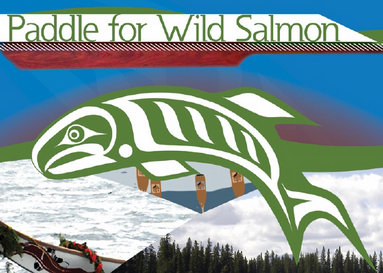
"Paddle for Wild Salmon," 2010.
Salmon Are Sacred Campaign |
|
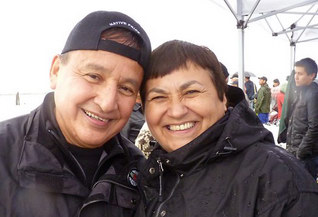
Chief Stuart Phillip and his wife Joan.
Paddle for Wild Salmon, 2010 |
|
| |
|
|
 |
|
| |
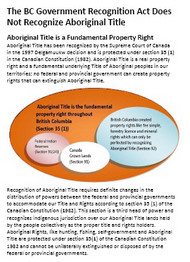 |
Left: The BC Government Recognition Act Does Not Recognize Aboriginal Title
by Arthur Manuel, 2009
(click for pdf)
Right: Sovereign Indigenous Nations Territorial Boundaries, Union of BC Indian Chiefs, 1993
Revived by the Ministry of Reconciation, June 2009
(click for pdf) |
|
|
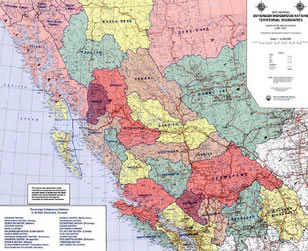 |
|
| |
|
|
|
|
| |
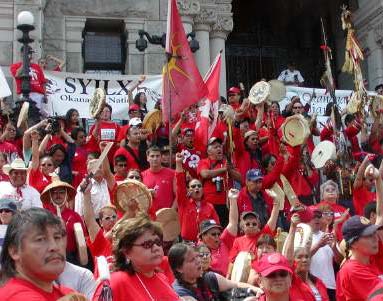
Aboriginal Title & Rights rally, Victoria, 2004.
Photo: Union of BC Indian Chiefs
First Nations protesters demonstrated their strength, unity and dedication to achieve justice. "Only First Nations can provide the certainty that the provincial Crown and resource industries are craving," says Chief Stewart Phillip, president of the Union of BC Indian Chiefs. "Until just accomodation of our Title occurs, neither businesses nor their investors will have the economic certainty they seek." |
|
On 20 May 2004 thousands of indigenous people from all parts of BC travelled to Victoria, capital city of BC (left) to protest at the BC Legislature against the lack of progress by the government on resolving land title issues and native rights. The sprawling colonial edifice was itself built illegally on designated Songhees Indian Reserve land. One large protest banner at the Aboriginal Title & Rights rally reads: "Our Land – Our Rights – Our Future" (below).
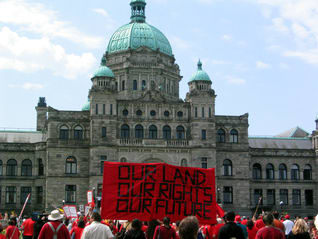
Aboriginal rally, Victoria, 2004.
Photo: Northern Shuswap Tribal Council |
|
| |
|
|
 |
|
| |
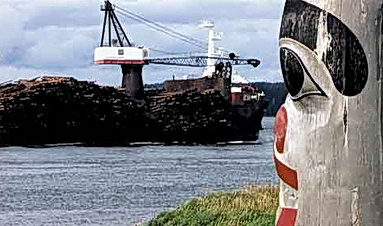
Log barge off Haida Gwaii.
Black Ship of Deforestation & Death
The 2005 film "Athlii Gwaii: The Line at Lyell" was based on raw footage taken in 1985 during the blockade on Lyell Island, Haida Gwaii. So far, privatization of forests in the hands of these scoundrels has only resulted in rampant timber liquidation and "value added" real estate opportunities.
Canadians have been brainwashed to accept a predatory economic system and the entitlement to a growth rate at least four times what forests can possibly grow. Full speed ahead yell the captains of the Titanic. The insane controllers of a terminal economic system thus need fixing, not just the forestry, and certainly not the forests. For over two decades the artist and forest activist has used his art to protest against the clearcut logging and plundering of Haida Gwaii. See his drawings: Red Stump. A ground breaking Haida protest was the 1985 Lyell Island blockade (left). This action against overcutting by transnational logging companies was spearheaded by Haida elders. It succeeded in forcing the government to establish the now world renowned Haida heritage site:
Gwaii Haanas. |
|
The geographical existance of the homeland of the Haida People was acknowledged in 2008 when its colonial title, the Queen Charlotte Islands, was finally dropped in favour of Haida Gwaii. For many decades, the Haida have watched the plunder and deforestation of their islands (left).
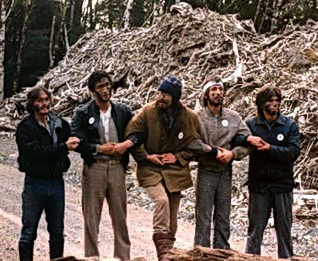
Lyell Island blockade, Haida Gwaii, 1985.
Photo: Gowgai Institute

Haida protest, Haida Gwaii, April 2005.
Photo: Roberta Aiken |
|
| |
|
|
 |
|
| |
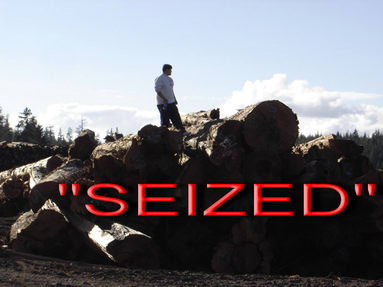
Haida protest against logging, Haida Gwaii, 2005.
Photo: Island Spirits Rising (text added)
The government's 2004
Memorandum of Understanding with the logging companies did nothing to stop the clearcutting. "When Weyerhaeuser decided to sell off its Tree Farm Licence 39 to Brascan Canada [in 2005], alarm bells went off throughout Haida Gwaii. . . . our Provincial Government has avoided its duty to consult and accommodate with the Haida Nation, weakened its own authority to act for any of its citizens and sell us all down their river of greed. But the Islands Spirit is rising. . . The blockade keeps Weyerhaeuser staff and Ministry of Forests from getting to their place of work" Haida activist Margo Hearne,
Islands Spirit Rising.
In 2005 the Haida established the Island Spirits Rising blockade to demand that the deforestation of Haida Gwaii by the government and transnational logging companies stop:
Islands Spirit Rising. The
Council of the Haida Nation took its case to the Supreme Court of Canada: "Haida Nation versus British Columbia and Weyerhaeuser." For more information on this important case and the relationship between aboriginal peoples, the Crown and Canadians, see the legal firm:
Eagle (Environmental Aboriginal Guardianship through Law and Education). |
|
n 2005, the CHN participated with most people living on Haida Gwaii in Islands Spirit Rising. This all Island shared initiative raised awareness around the lack of respect being given the Supreme Court of Canada, TFL 39 Case decision. In part, the decision said that the government of British Columbia must consult and accommodate when making decisions that affect First Nations. In the face of this, the local Ministry of Forest office started approving cut blocks that started to reduce options for the Land Use Planning Table by logging areas under consideration. People said Enough is Enough and took a stand. From this joint, all Island position some very positive negotiations with the Province of BC have taken place including the protection of significant cultural areas for future generations. (see map)
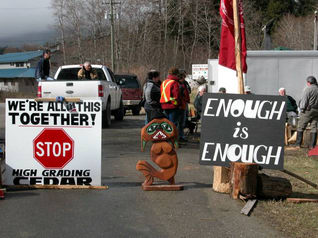
Haida protest, Haida Gwaii, April 2005.
Photo: Roberta Aiken |
|
| |
|
|
|
|
| |
The Klabona Keepers Elders Society is dedicated to protecting Tahltan Territory: "The Sacred Headwaters is a highly traditional use area valued by many Nations that depend on it for their very survival." To protest the invasion of their hunting grounds by Shell, on 2 March 2005 courageous members of the Tl'abanot'in Clan, Iskut First Nation and Tahltan Elders confronted company officials and ordered them to leave Iskut land. Iskut Elder James Dennis told them: "Our land is our kitchen. When you bring your poison onto our land you are poisoning our kitchen. We will not stand for that, so go back to where you came from." |
|

Get the Shell Out!, Tahltan protest, 2005.
Photo: Klabona Keepers |
|
| |
|
|
|
|
| |
On 12 February 2007 members of the Kwakiutl First Nation from Tsaxis (Fort Rupert) on northern Vancouver Island travelled to Victoria to demonstrate at the BC Legislature. They were protesting against the government's sleazy and underhanded land transfer with Western Forest Products which is an infringement of their Aboriginal Rights and Title. Kwakiutl Elder Basil Ambers (31 December 1931 – 23 March 2008) led the procession (right). The deal is proof that nothing has changed since a decade earlier, in 1997, when Basil Ambers as a spokesperson for the Kwaliutl Elders, commented to the Committee on Aboriginal Affairs: |
|
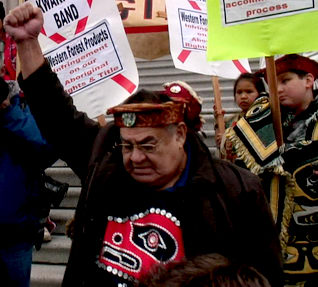
Kwakiutl protest, Victoria, 12 February 2007.
Photo: G. T. Wm. Edwards |
|
| |
|
|
|
|
| |
"One of the things I would like to level at you people is that you don't know anything about us. You have no knowledge whatsoever of our culture and how our institutions work. You have no knowledge of our potlatch system and how that system works within us and how it works as our government. Everything we ever do in this world comes out of that potlatch system. Even though we are the most studied people in Canada, you people don't know a thing about us, absolutely nothing. You've had anthropologists by the dozens come to our country. The Kwakiutl have been studied and studied. There are reams and reams of books on the potlatch system and on our type of government, and I bet there isn't one of you sitting up there that can tell me anything about it. I bet you are all ignorant of what it's all about. That's why I sit here and I sort of seethe. I know the actual ridiculousness of us trying to get a treaty with you people, because of things like that"
Basil Ambers. |
|
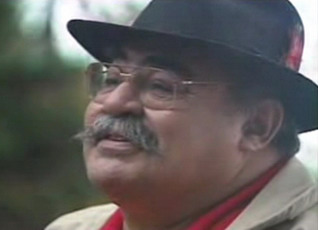
Kwakiutl Elder Basil Ambers.
Screenshot: Severing the Web |
|
| |
|
|
|
|
| |
Another landmark First Nations protest against logging was on Meares Island in 1985. The Tlaquiaht and Ahousaht tribes initiated a blockade to prevent Macmillan Bloedel from destroying the ancient trees. The company took out an injunction against Chief Moses Martin, a traditional Tlaoquiaht carver of dugout cedar canoes from the village of Opitsaht. Joe Martin continues the family carving tradition and he took part in the renowned Clayoquot Sound protests of 1993 (above).
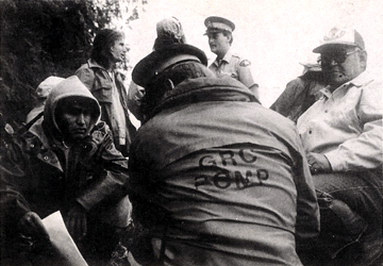
Ahousaht Earl George, Clayoquot Sound, 1988.
Photo: Wilderness Committee |
|
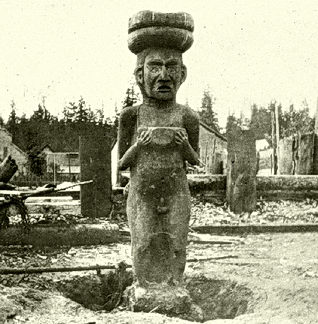
Ahousaht figure, Clayoquot Sound.
Photo: BC Archives
BC Forest Massacres sulpher-passage-earl-george-right-injunction-wcwc-1988 |
|
| |
|
|
|
|
| |
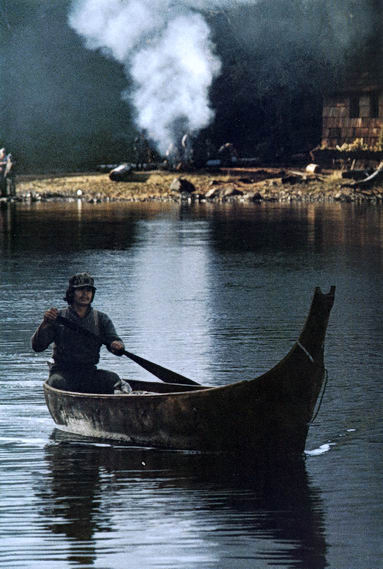
Joe Martin, C'is a qis Bay, 1984.
Photo: Adrian Dorst |
|
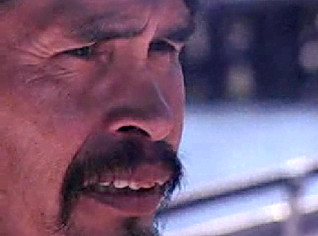
Tlaoquiaht Joe Martin, 1993.
Screenshot: GreenDream$
In the 1999 documentary video by Daniel Gautreau: GreenDream$, Joe Martin expresses: his opposition to the forest runination companies: "Our peoples never okayed these clearcuts ever since they began in the traditional territories of our chiefs. . . that's who this land belongs to."
First Nations carvers such as Joe Martin well understand the crisis of deforestation in BC. It is increasingly difficult to find the large cedar logs that are needed for Northwest Coast carving, especially for the dugout canoes and totem poles that First Nations artists are world renowned for (above). To First Nations, the cedar is so important for their culture that it is known as the Tree of Life, but for the lumber industry it is simply a profitable natural resource. |
|
| |
|
|
 |
|
| |
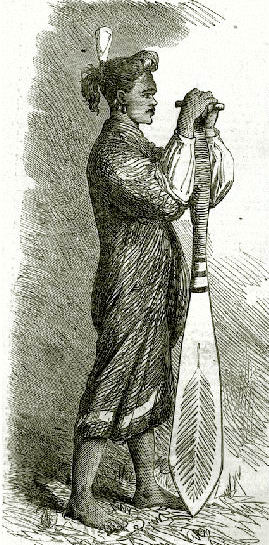 |
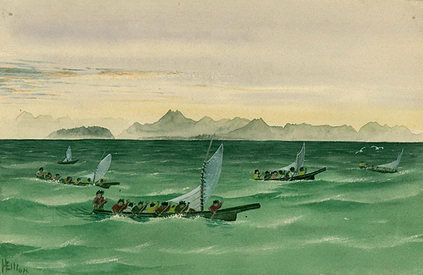
Above: Watercolour entitled "Coast of Vancouver Island, off Clayoquot Sound, June 30, 1874." By Henry Wood Elliot, Smithsonian Institution.
The rich fisheries off the West Coast of Vancouver Island have been severely depleted since the 1874 painting of natives fishing the halibut shoals (above). Also the forest resources have been robbed from the indigenous peoples, leaving the land degraded and salmon rivers ruined. Of all Northwest Coast communities, the Tla o qui aht were most famed for their ferocity and resistance to the colonial invaders.
Left: Engraving entitled "An Indian with a flag of truce in Clayoquat [sic]." Unknown engraver and source, BC Archives. The engraving is likely Chief Wickaninnish and relates to a true event at Clayoquot in 1811. But the Chief's reported surrender and the flag of truce is a colonial invention. Similarly suspicious is BC's treaty process, which has been rejected by Tla o qui aht muschim (community members).
Reference: Chiinuuks (Ruth Ogilvie):
Muschim Raise Treaty Concerns |
|
|
| |
|
|
|
|
| |
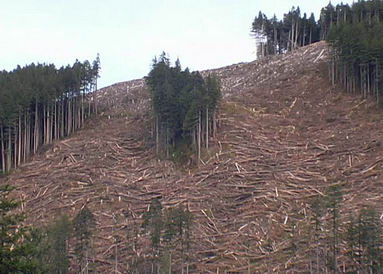
Weyerhaeuser clearcut, Vancouver Island, 2004.
Photo: Richard Boyce
Lumber corporations have "legally stolen" First Nations land with the colluding support of the BC government. Timber farm licences and forest range agreements are made without having resolved the issue of Aboriginal Title and Rights. The result is the devastation of entire watersheds such as on Vancouver Island in Nuu Chah Nulth Territory (above). In 2005, Hupacasath First Nation sued the BC government and logging industry: Hupacasath First Nation versus BC. Chief Councillor Judith Sayers reported after the Court success: "Today is a victory, not just for the Hupacasath, but for our Forests, and all that grows and lives within them. The Forests are our Cathedrals and we hope through the consultation process that the Court has ordered that we will be able to protect that which is most sacred and precious to us" Hupacasath Release. Welcome figures by Nuu chah nulth carvers Rod Sayers and Cecil Dawson bring a new focus to the lumber industry town of Port Alberni (right). |
|
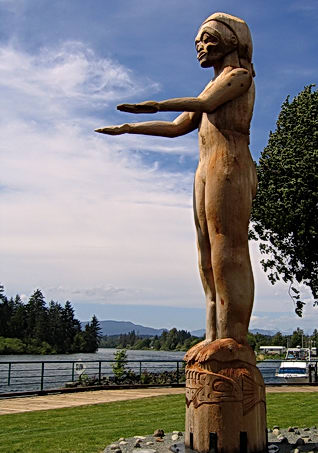
Nuu chah nulth figure, Port Alberni.
Photo: Karen Wonders |
|
| |
|
|
|
|
| |
The BC Ministry of Aboriginal Relations and Reconciliation is little more than a devious scheme using the rhetoric of "respect, recognition and accommodation" to cover up the greedy "business as usual" policies of the government. Many indigenous people see also the BC treaty process as part of a cynical and self serving political manoeuver to extinquish Aboriginal Title and Right and they reject all negotiations. Read a condemnation by the Indigenous Network on Economies and Trade: Treaty Negotiating Times. If the Ministry was serious about a new relationship, then it would immediately put a stop to the destruction of aboriginal heritage that is taking place all over the province in the form of unregulated real estate development including Bear Mountain Resort, 15 km from the BC Legislature (right).
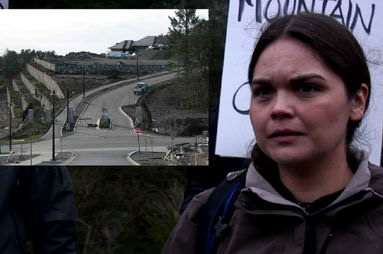
Bear Mt Resort sprawl, Victoria, 2007.
Photo: Karen Wonders |
|
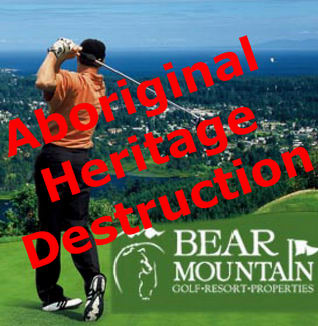
"Bear Mountain Golf Resort Properties."
Commercial ad (red text added)
Treesit To Stop Resort Sprawl Bear Mt Resort (above) is a typical example of how corrupt local politicians are ganging up with big business against the interests of First Nations. In this case Western Forest Products was involved in an illicit land transfer to a property speculator in 2001 which enabled him to wreck an indigenous heritage site and put in jeopardy the watershed of Goldstream Park, a much loved tourist attraction with a rare and irreplaceable salmon bearing river.
Save Nanoose Bay Forest |
|
| |
|
|
|
|
| |
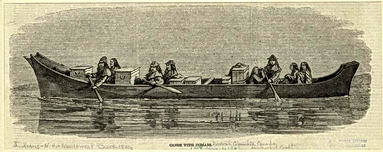
Coast Salish canoe, c. 1880.
Book engraving |
|
Like the rivers, the wetlands of BC are being destroyed by big business. The Fraser River is one of the world's greatest salmon rivers, yet industrial development and urban sprawl continue to jeopordize the survival of the salmon runs. One of the few remnants of biodiversity on the Fraser delta is the Reifle Bird Sanctuary (above). |
|
| |
|
|
|
|
| |
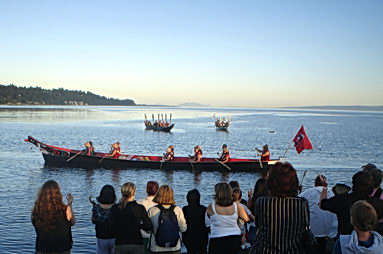
Traditional Salish canoes.
Photo:anon
Tsawwassen First Nation member Bertha Williams (right) takes a brave stand as she describes the unethical tactics taken against her people. See the 2007 video by Damien Gillis: Lone Voice. Lone Voice Defies TFN Treaty Manipulation second MLA removed from the NDP caucus for speaking/voting his conscious. Remember Michael Sather who could not vote for the section of the Tsawwassen Treaty that removed land from the ALR?Bertha Williams of the Tsawwassen Band who opposed the Tsawwassen Treaty has been to the United Nations twice. The UN found that the Treaty was illegal. Lone Voice Defies TFN Treaty Manipulation |
|
The delta is where the government plans to develop a massive commercial cargo port as part of its controversial $2.5 billion Gateway project.
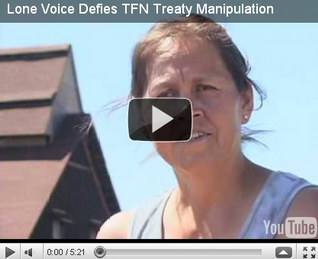
Bertha Williams.
Screenshot: Lone Voice |
|
| |
|
|
|
|
| |
Non native environmentalists in BC increasingly support Aboriginal Title and Rights as they recognize that they are confronting the same forces of destruction as First Nations have been battling ever since colonization. A new threat to First Nations land and heritage is the rush to privatize rivers to produce hydro energy. See: Save Our Rivers Society. The need to work together is expressed with great wisdom by Chief Kukpi7 Wayne M. Christian Election Campaign of Splats'in First Nation (right). In the video Save Our Rivers, Chief Christian describes the government's unethical tactics in trying to force First Nations to agree to nature destroying schemes that primarily benefit big business and serve to further divide and conquer First Nations and weaken their land title. |
|
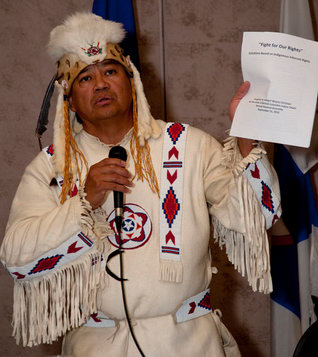
Chief Kukpi7 Wayne M. Christian, 2010.
Splats'in First Nation |
|
| |
|
|
|
|
| |
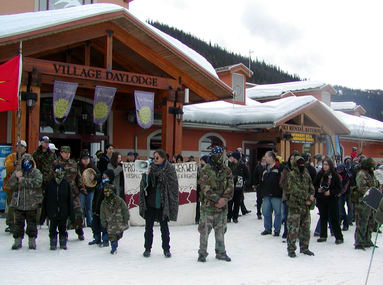
Sun Peaks protest, 11 March 2007.
Photo: anon |
|
The abuse of Aboriginal Title and Rights is blatant in the case of the rampant development of winter sport resorts backed by the government. See the German report. German support actions: Secwepemc activists established Skwelkwek'welt Protection Centre in protest in 2000. The Native Youth Movement held a demonstration against Sun Peaks on 11 March 2007 (left). In Vienna on 27 June 2007 Secwemempc activist Arthur Manuel appealed to the Austrian Ski Team not to abuse indigenous rights by training at Sun Peaks. |
|
| |
|
|
|
|
| |
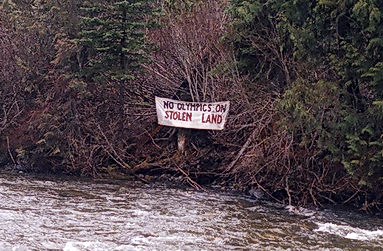
Lilwat Guardian at Sutikahl, 2006.
Photo: Karen Wonders
The BC government's 2010 Winter Olympics in Vancouver - Whistler to violates the rights of the indigenous peoples by the privatization of their land, before Aboriginal Title has been resolved. InSHUCKch Final Agreement: Is This What We Wanted? Kerry Coast, The St’át’imc Runner Newspaper July 2007 The InSHUCkch treaty office and the negotiations team claim many things for the InSHUCKch Final Agreement. However, Draft 13 of the treaty raises serious questions about the validity of these claims. Presentations, newsletters, brochures and interviews made by treaty employees make grand statements: a treaty "gives" rights; the Lillooet River communities will have more control over their traditional territories; economic development hinges on treaty; self determination will be realized by treaty; there will be "certainty" but no "extinguishment;" all Social Services currently provided by Canada or BC will continue, and there will be "treaty rights on top." A BC treaty might be an improvement, if you start from the same page as the BC government, and take for granted many of Canada's genocidal policies as law, which they are not. You would have to completely overlook the fact that aboriginal title exists now, and a great deal of rights flow from that title. Those existing aboriginal title and rights, which are the reason for the current treaty process, would no longer be enjoyed by InSHUCKch Nation post-treaty. Only the rights which are identified in the treaty, no more or less, and no title to the land, only fee-simple title of 14,577 hectares, with underlying ownership by BC. But what of the other promise a BC treaty might hold? In response to a request for a copy of the Agreement in principle, the Lower St'lát'limx Tribal Council provided The Runner with a copy of Draft 13 of the InSHUCKch Final Agreement, dated April 30, 2007. It is worthwhile comparing the treaty employees’ claims to the provisions of the Final Agreement. Control Over Traditional Territory The InSHUCKch have used treaty money to produce some important works. One of these is the Land Stewardship Plan, which has begun, over the last two years, to document traditional land use and potential land use. How this information will be used is another question.Propaganda by the BC government is designed to hide its unethical strategy of coopting individuals to rob First Nations of their collective rights to ancestral lands and resources. Read a July 2007 critique in the St'at'imc Runner of the InSHUCKch First Nation deal:
Is This What We Wanted? |
|
A resort project has been approved for Melvin Creek, in territory belonging to St'at'imc Nation. St'at'imc activists established the Sutikahl camp in 2000 to defend their land from property developers. Already in 2002 First Nations Elders expressed their concerns to the International Olympics Committee. See: Official Complaint.

Lilwat Guardian at Sutikahl, 2006.
Photo: Karen Wonders |
|
| |
|
|
|
|
| |
Nuxalk people have consistently demanded sovereignty and refused to be coopted by the BC government and big business concerning environmental and territorial issues. Because of this principled position, the Nuxalk have suffered both economically and socially. "The reoccupation, asserting and reaffirming of Nuxalk sovereignty protects the rainforests in the mid coast of BC. Other methods stall the clearcut destruction of the rainforests but only temporarily. Reoccupation is a long term strategy which draws public attention to the destruction of Nuxalk lands. Our chiefs, our elders and our people go out to stop the destruction of our land and face criminal charges in court as a result" Qwatsinas, |
|
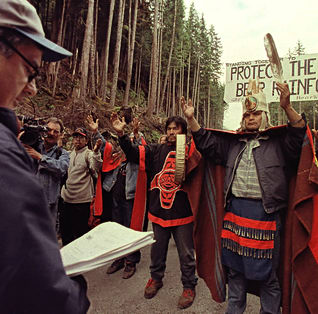
Protest against Interfor, Ista, 1995.
Photo: Nuxalk House of Smayusta |
|
| |
|
|
|
|
| |
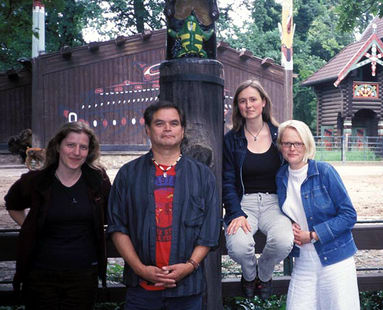
Qwatsinas (centre), Berlin, 2002.
Photo: Nuxalk House of Smayusta |
|
Nuxalk House of Smayusta Chief Qwatsinas took part in a tour of Germany in 2002 (left) to inform Europeans about the dire situation of the Nuxalk. Many Germans therefore know about the brutal Interfor clearcutting of Nuxalk Territory (above). German Nuxalk supporters (from l.): Solveig Lubeley, Taiga Rescue Network, Lydia Bartz and Agnes Diekman of urgewald. Not present in the photo is Jutta Kill of FERN (Forests and the European Union Resource Network). These three international organizations advocate environmental policies and practices worldwide that focus on forests and the rights of forest peoples such as the Nuxalk.
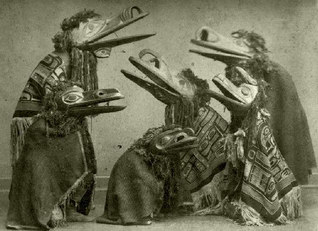
mmmmm.
mmmmmmm |
|
| |
|
|
|
|
| |
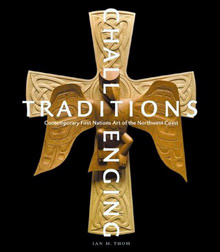 |
Left: Cover of the book "Challenging Traditions" (2009) by Ian Thom. Features a carving in yellow cedar, the most sacred tree, native to Vancouver Island, by Haida artist Don Yeomans. Only a boycott of the non native commercial trade in yellow cedar will preserve the indigenous carving traditions endangered by industrial forestry.
Right: From "Challenging Traditions," a carving in cedar by Kwakiutl Wayne Alfred, "Salmon Transformation Mask" |
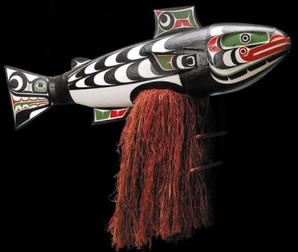 |
|
|
| |
|
|
 |
|
| |
|
|
| |
©
Credits & Contact |
|
| |
|
|
|
|

